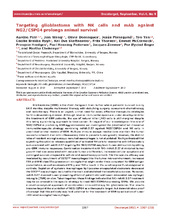Targeting glioblastoma with NK cells and mAb against NG2/CSPG4 prolongs animal survival
Poli, Aurélie; Wang, Jian; Domingues, Olivia; Planagumà, Jesús; Yan, Tao; Rygh, Cecilie Brekke; Skaftnesmo, Kai Ove; Thorsen, Frits Alan; McCormack, Emmet; Hentges, François; Pedersen, Paal-Henning; Zimmer, Jacques; Enger, Per Øyvind; Chekenya, Martha
Peer reviewed, Journal article
Published version
Permanent lenke
https://hdl.handle.net/1956/7864Utgivelsesdato
2013-09-09Metadata
Vis full innførselSamlinger
Sammendrag
Glioblastoma (GBM) is the most malignant brain tumor where patients’ survival is only 14.6 months, despite multimodal therapy with debulking surgery, concurrent chemotherapy and radiotherapy. There is an urgent, unmet need for novel, effective therapeutic strategies for this devastating disease. Although several immunotherapies are under development for the treatment of GBM patients, the use of natural killer (NK) cells is still marginal despite this being a promising approach to treat cancer. In regard of our knowledge on the role of NG2/CSPG4 in promoting GBM aggressiveness we investigated the potential of an innovative immunotherapeutic strategy combining mAb9.2.27 against NG2/CSPG4 and NK cells in preclinical animal models of GBM. Multiple immune escape mechanisms maintain the tumor microenvironment in an anti-inflammatory state to promote tumor growth, however, the distinct roles of resident microglia versus recruited macrophages is not elucidated. We hypothesized that exploiting the cytokine release capabilities of activated NK cells to reverse the anti-inflammatory axis combined with mAb9.2.27 targeting the NG2/CSPG4 may favor tumor destruction by editing pro-GBM immune responses. Combination treatment with NK+mAb9.2.27 diminished tumor growth that was associated with reduced tumor proliferation, increased cellular apoptosis and prolonged survival compared to vehicle and monotherapy controls. The therapeutic efficacy was mediated by recruitment of CCR2low macrophages into the tumor microenvironment, increased ED1 and MHC class II expression on microglia that might render them competent for GBM antigen presentation, as well as elevated IFN-γ and TNF-α levels in the cerebrospinal fluid compared to controls. Depletion of systemic macrophages by liposome-encapsulated clodronate decreased the CCR2low macrophages recruited to the brain and abolished the beneficial outcomes. Moreover, mAb9.2.27 reversed tumor-promoting effects of patient-derived tumor-associated macrophage/ microglia (TAM) ex vivo. Taken together, these findings indicate that NK+mAb9.2.27 treatment may be an amenable therapeutic strategy to treat NG2/CSPG4 expressing GBMs. We provide a novel conceptual approach of combination immunotherapy for glioblastoma. The results traverse beyond the elucidation of NG2/CSPG4 as a therapeutic target, but demonstrate a proof of concept that this antibody may hold potential for the treatment of GBM by activation of tumor infiltrated microglia/macrophages.

